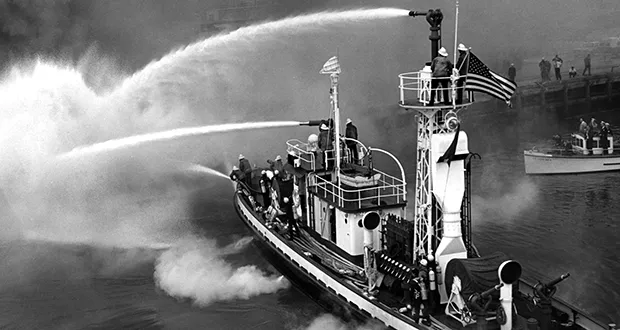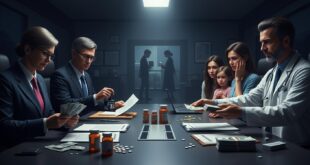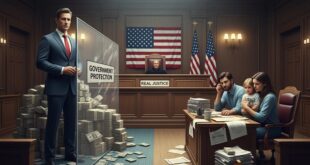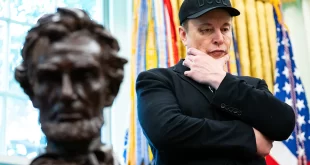The Test They Said Was Harmless
In the autumn of 1950 the U.S. Navy quietly parked ships in the San Francisco Bay and released a cloud of so called harmless microbes into the coastal air. The operation had a friendly code name that reads like the title of a travel brochure. Operation Sea Spray. The target was not an enemy military base. It was ordinary American neighborhoods. The goal was to see how a biological agent would drift, settle, and spread through a modern city wrapped in fog. The government did not bother asking the citizens for consent. It did not even tell them afterward. That truth only surfaced decades later when hearings and declassifications peeled back the curtain. You can read a straightforward overview of the test here in the summary on Operation Sea Spray and then compare it with the historical analysis of open air trials compiled for public health journals such as this review on open air biowarfare testing.
The Navy used Serratia marcescens and Bacillus globigii as simulants because they were cheap to grow and easy to track in samples. At the time, officials claimed these organisms were benign. Later clinical literature documented real infections tied to Serratia and described how cavalier those assumptions were. If you want the medical side without politics, look at the New England Journal of Medicine’s historical review of Serratia marcescens outbreaks and a broader clinical survey that walks through the organism’s disease profile in detail here in the National Library of Medicine’s collection on Serratia infections. The science is clear enough. This was not pixie dust. It was a living organism that can colonize catheters, cause bloodstream infections, and seed pneumonia in vulnerable people.

What makes this test feel even worse is the context. Only a few years after the Nuremberg Code set a moral baseline for human subjects research, our own military took to the bay and turned a major American city into a laboratory. This is not paranoia. This is documented by sources ranging from the Smithsonian’s digest piece on how the Navy released a bioweapon simulant over San Francisco to federal archives summarizing Cold War test programs across the country. The Deseret News also pulled records showing the routine use of Bacillus globigii as a supposed safe stand in during later tests, including specific dosage planning, which is chilling to read in bureaucratic prose. You can see that reporting here in their explainer on Navy and Army simulant trials.
Beginning on September 26, 1950, the crew of a U.S. Navy minesweeper ship spent six days spraying Serratia marcescens into the air about two miles off the northern California coast. Smithsonian Magazine
Illness, A Death, And A Lawsuit The Government Could Shrug Off
After the spray, San Francisco saw a cluster of unusual infections. One patient, Edward J. Nevin, developed a Serratia infection and died. His family later brought suit, only to run headlong into the legal shield that protects federal agencies when policy decisions go bad. The Wall Street Journal’s retrospective notes the family’s claim and the government’s immunity posture, which should make any citizen bristle because it means there is almost no accountability when officials run careless experiments on the people who pay their salaries. The WSJ piece gives a concise summary of how the Army and Navy staged mock biological attacks and how Nevin became the face of the human cost.

The medical record around Serratia in that era is not a mystery. Stanford clinicians documented an unusual run of infections soon after the San Francisco tests, which you can see referenced in NEJM’s historical notes on the 1951 Stanford University Hospital cluster. The National Library of Medicine collections add further detail and context, showing that what planners once called harmless was anything but harmless in the real world.
When the truth finally cracked open in the 1970s, it was not because the bureaucracy found its conscience. It was because Congress started asking hard questions. The Church Committee era became a rare moment when oversight actually bit down. The U.S. Senate’s own historical page summarizes those hearings and how they exposed a long list of covert programs that had no business being hidden from the people. For a broader background on that oversight period there is a reliable primer at the Levin Center.
Army witnesses disclosed that from 1949 to 1969, 239 open air tests were conducted in populated areas throughout the United States. American Journal of Public Health
The Pattern Is The Problem
The San Francisco test was not a one off mistake. It sat inside a wider playbook of open air trials that scattered microbes and simulants over cities, subways, ships, and bases. The PBS American Experience archive gives a plain language overview of more than two hundred such tests, which you can skim here in their summary of secret domestic testing programs during the Cold War era. Government planners considered Bacillus globigii a stand in for something nastier and even charted minimum respiratory doses for crew exposure during sampling, as the Deseret News document pull shows.
If you want the paper trail beyond media summaries, look at declassified compilations gathered by the National Security Archive. The documents lay out how field testing was expanded after 1950 and how places such as Dugway Proving Ground served as hubs for biological and chemical trials. You can pair it with the Defense Health Agency’s site that explains Dugway’s role in chemical and biological testing.
The moral of the story is not complicated. When government power is unobserved it expands. When agencies can classify mistakes as national security, the mistakes multiply. When the press finally gets the receipts everyone is told to calm down because the events are ancient history. That is how public trust dies. It is also how politicians learn they can get away with anything so long as they use the right vocabulary and keep the paperwork buried. The antidote is not blind faith. It is sharp oversight, vigorous disclosure, and the refusal to let the people who made the mess write the only report about the mess.
These nationally televised events offered the American public an opportunity to learn about the secret operations conducted for decades by U.S. intelligence agencies. U.S. Senate historical page
Why This Matters Now
This history matters every time an agency asks for broader emergency powers or insists that public health demands obedience without debate. You can respect real science and still demand accountability for what happened in San Francisco. You can accept that the Cold War was tense and still reject the idea that American citizens are acceptable test subjects. Even public health scholars who write in careful academic language acknowledge the scale of what was done. The AJPH review by Leonard Cole puts a number to the trials and makes clear that the ethics evolved only after public exposure, not before it.
There is also a lesson about how narratives get cleaned up. Planners called Serratia harmless. Clinicians later chronicled infections and injuries. Bureaucrats called the tests necessary. Families who lost loved ones were told that sovereign immunity takes priority over justice. You see that arc plainly when you jump from the Smithsonian’s accessible write up to the clinical papers and then to the Wall Street Journal retrospective on Nevin. Connect those dots yourself using the WSJ archive on military germ spraying along with the NEJM historical notes on the early Stanford cluster and the broader NLM clinical review.
So what is the practical takeaway for readers now. Trust must be earned and verified. When agencies want to run experiments that touch the public they must obtain consent, publish protocols, and accept responsibility for outcomes. When institutions refuse, citizens should use the tools still available. Ask for documents. File requests. Support lawmakers who actually do oversight rather than protect agencies from embarrassment. The Church Committee era shows that sunlight works when it is wielded with persistence and courage. The Senate’s own page on that history is worth bookmarking here in the official summary.
Determined to anticipate possible Soviet attacks, the U.S. staged more than 200 domestic tests aimed at assessing national vulnerabilities. PBS American Experience
 Heroic Outfitters
Heroic Outfitters



